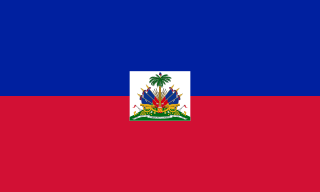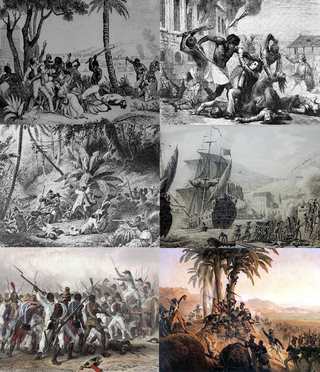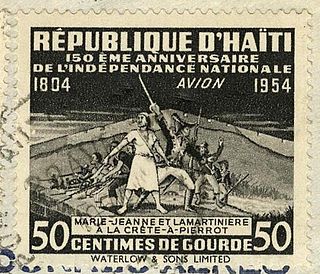Related Research Articles

Henri Christophe was a key leader in the Haitian Revolution and the only monarch of the Kingdom of Haiti.

François-Dominique Toussaint Louverture also known as Toussaint L'Ouverture or Toussaint Bréda, was a Haitian general and the most prominent leader of the Haitian Revolution. During his life, Louverture first fought and allied with Spanish forces against Saint-Domingue Royalists, then joined with Republican France, becoming Governor-General-for-life of Saint-Domingue, and lastly fought against Bonaparte's republican troops. As a revolutionary leader, Louverture displayed military and political acumen that helped transform the fledgling slave rebellion into a revolutionary movement. Along with Jean-Jacques Dessalines, Louverture is now known as one of the "Fathers of Haiti".

Jean-Jacques Dessalines was the first Haitian Emperor, leader of the Haitian Revolution, and the first ruler of an independent Haiti under the 1805 constitution. Initially regarded as governor-general, Dessalines was later named Emperor of Haiti as Jacques I (1804–1806) by generals of the Haitian Revolutionary army and ruled in that capacity until being assassinated in 1806. He spearheaded the resistance against French rule of Saint-Domingue, and eventually became the architect of the 1804 massacre of the remaining French residents of newly independent Haiti, including some supporters of the revolution. Alongside Toussaint Louverture, he has been referred to as one of the fathers of the nation of Haiti. Dessalines was directly responsible for the country, and, under his rule, Haiti became the first country in the Americas to permanently abolish slavery.

Divisional General Charles Victoire Emmanuel Leclerc was a French Army officer who served during the French Revolutionary Wars. He was the husband of Pauline Bonaparte, the sister of Napoleon. In 1801, Leclerc was sent to Saint-Domingue, where invasion forces under his command captured and deported Haitian leader Toussaint Louverture to France as part of an unsuccessful attempt to reassert French control over Saint-Domingue and reinstate slavery in the colony. Leclerc died of yellow fever during the campaign.

Alexandre Sabès Pétion was the first president of the Republic of Haiti from 1807 until his death in 1818. One of Haiti's founding fathers, Pétion belonged to the revolutionary quartet that also includes Toussaint Louverture, Jean-Jacques Dessalines, and his later rival Henri Christophe. Regarded as an excellent artilleryman in his early adulthood, Pétion would distinguish himself as an esteemed military commander with experience leading both French and Haitian troops. The 1802 coalition formed by him and Dessalines against French forces led by Charles Leclerc would prove to be a watershed moment in the decade-long conflict, eventually culminating in the decisive Haitian victory at the Battle of Vertières in 1803.

The flag of Haiti is a bicolour featuring two horizontal bands coloured blue and red, emblazoned by a white rectangular panel bearing the coat of arms of Haiti. The coat of arms depicts a trophy of weapons atop a green hill and a royal palm symbolizing independence. The palm is topped by the Cap of Liberty. The motto L'Union fait la Force appears on a white ribbon below the arrangement.

Ouest or Lwès is one of the ten departments of Haiti. It is located in south-central Haiti, linking the Great-North and the Tiburon Peninsula.

The Haitian Revolution was a successful insurrection by self-liberated slaves against French colonial rule in Saint-Domingue, now the sovereign state of Haiti. The revolution was the only known slave uprising in human history that led to the founding of a state which was both free from slavery and ruled by non-whites and former captives.

The Battle of Vertières was the last major battle of the Haitian Revolution, and the final part of the Revolution under Jean Jacques Dessalines. It was fought on 18 November 1803 between the enslaved Haitian army and Napoleon's French expeditionary forces, who were committed to regaining control of the island.

Donatien-Marie-Joseph de Vimeur, vicomte de Rochambeau was a French military commander. He was the son of Jean-Baptiste Donatien de Vimeur, comte de Rochambeau.

The Saint-Domingue expedition was a large French military invasion sent by Napoleon Bonaparte, then First Consul, under his brother-in-law Charles Victor Emmanuel Leclerc in an attempt to regain French control of the Caribbean colony of Saint-Domingue on the island of Hispaniola, and curtail the measures of independence and abolition of slaves taken by the former slave Toussaint Louverture. It departed in December 1801 and, after initial success, ended in a French defeat at the Battle of Vertières and the departure of French troops in December 1803. The defeat forever ended Napoleon's dreams of a French empire in the West.

The Haitian Declaration of Independence was proclaimed on 1 January 1804 in the port city of Gonaïves by Jean-Jacques Dessalines, marking the end of 13-year long Haitian Revolution. The declaration marked Haiti becoming the first independent nation of Latin America and only the second in the Americas after the United States.
Joseph R. E. Bunel was a representative of the Haitian Revolutionary Government, who negotiated the first trade agreement between his nation and the United States, in 1799.

Cécile Fatiman was a Haitian Vodou priestess and revolutionary. Born to an enslaved African woman and a Corsican prince, she lived her early life in slavery, before being drawn to Enlightenment ideals of "liberté, égalité, fraternité" and Haitian Vodou, which shaped her desire to end the institution of slavery in Haiti. Together with Dutty Boukman, she led a Vodou ceremony at Bois Caïman and incited enslaved people to rise up against slavery, in an event that marked the beginning of the Haitian Revolution. She later married fellow revolutionary leader Jean-Louis Pierrot, with whom she had a daughter. She was reported to have lived a long life, dying at the age of 112.
Dédée Bazile, also known as Défilée or Défilée-la-folle, was a Haitian revolutionary and vivandière. She gathered the remains of Emperor Jean-Jacques Dessalines for burial.

Marie-Jeanne Lamartinière was a Haitian revolutionary, soldier, and nurse. Described as a Mulatto, she was raised on a plantation in Port-au-Prince. Marie-Jeanne received formal education before marrying Louis Daure Lamartinière, an officer of the Armée Indigène. In 1802, she fought alongside him and his army against French forces in the Battle of Crête-à-Pierrot. Her attire and weaponry were noted, and she was described as courageous. After a bombardment by the French, Marie-Jeanne retreated with Louis and his army, and after his death, she had relationships with two other army officers. Though little is known about Lamartinière, she is popular across Haiti and was printed on a postage stamp and coin.

The Indigenous Army, also known as the Army of Saint-Domingue was the name bestowed to the coalition of anti-slavery men and women who fought in the Haitian Revolution in Saint-Domingue. Encompassing both black slaves, maroons, and affranchis, the rebels were not officially titled the Armée indigène until January 1803, under the leadership of then-general Jean-Jacques Dessalines. Predated by insurrectionists such as François Mackandal, Vincent Ogé and Dutty Boukman, Toussaint Louverture, succeeded by Dessalines, led, organized, and consolidated the rebellion. The now full-fledged fighting force utilized its manpower advantage and strategic capacity to overwhelm French troops, ensuring the Haitian Revolution was the most successful of its kind.
During the Haitian Revolution (1791–1804), Haitian women of all social positions participated in the revolt that successfully ousted French colonial power from the island. The 1791 revolt of enslaved individuals in Saint-Domingue was the largest and most successful slave rebellion in modern history. In spite of their various important roles in the Haitian Revolution, women revolutionaries have rarely been included within historical and literary narratives of the slave revolts. However, in recent years extensive academic research has been dedicated to their part in the revolution.
Charles Belair (1778–1802) was Aide-de-Camp and lieutenant of Toussaint Louverture, Head of the 7th demi-brigade, Commandant of l'Arcahaye and Former lieutenant of Biassou. He was also a nephew of Toussaint Louverture. In 1796, he married Sanite Belair.
In 1789, France's National Constituent Assembly made the Declaration of the Rights of Man and of the Citizen. In 1791, the enslaved Africans of Saint-Domingue began the Haitian Revolution, aimed at the overthrow of the colonial reign.
References
- ↑ Henderson, H., ed. (2015). ""Haiti Flag and University Day"". Holidays, Festivals, and Celebrations of the World Dictionary. Detroit, MI: Omnigraphics, Inc.
- ↑ Girard, Philippe R. (2009-01-01). "Birth of a Nation: The Creation of the Haitian Flag and Haiti's French Revolutionary Heritage". Journal of Haitian Studies. 15 (1/2): 138, 141. JSTOR 41715156.
- ↑ Accilien, Cécile; Adams, Jessica; Méléance, Elmide, eds. (2006). Revolutionary Freedoms: A History of Survival, Strength and Imagination in Haiti. Coconut Creek, FL: Caribbean Studies Press. p. 91.